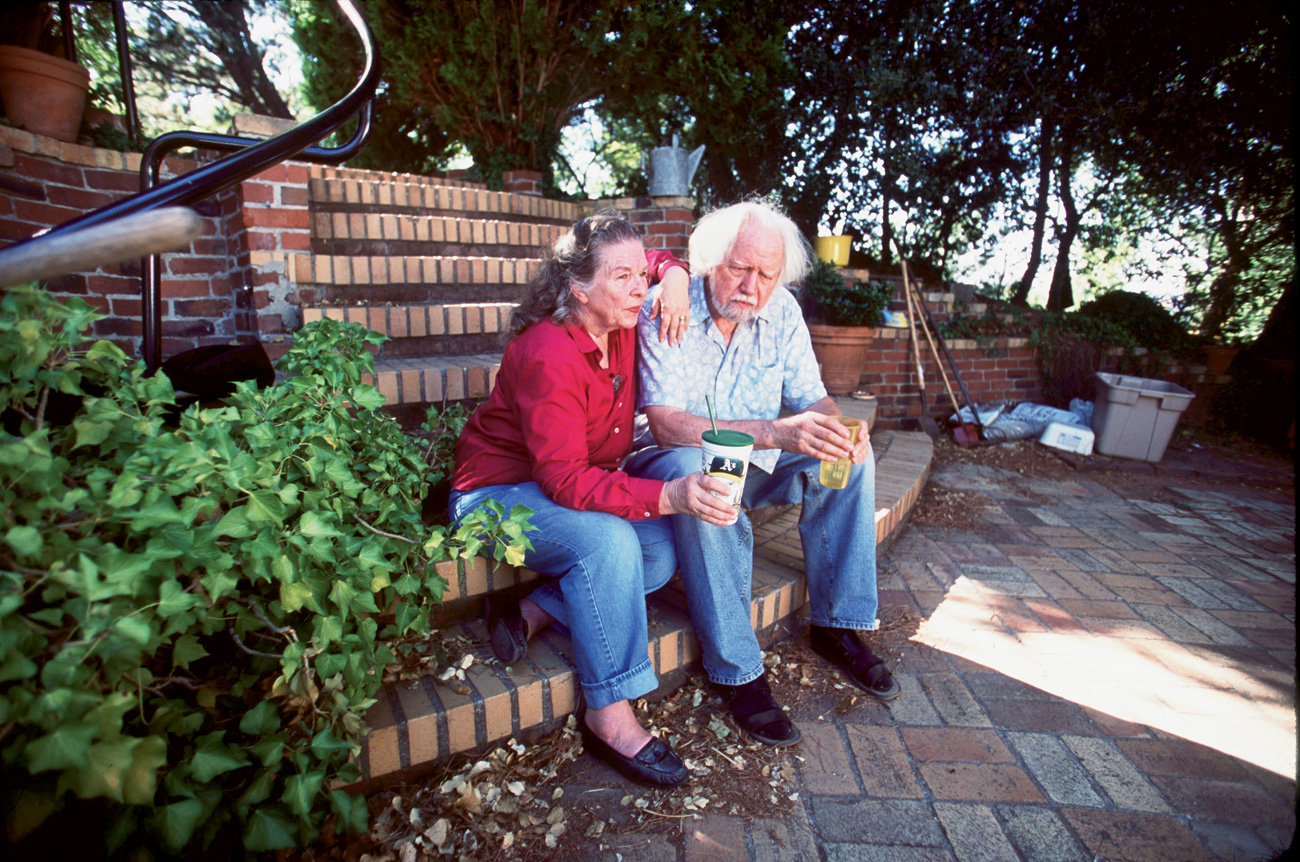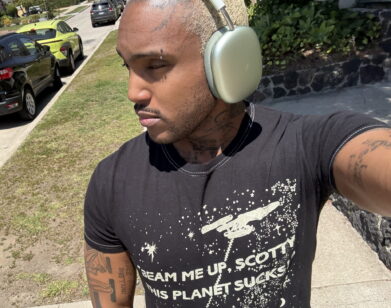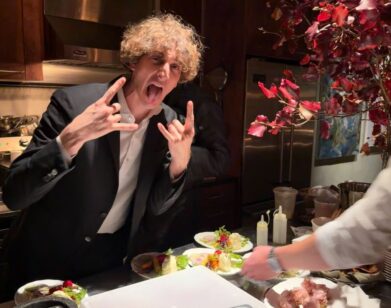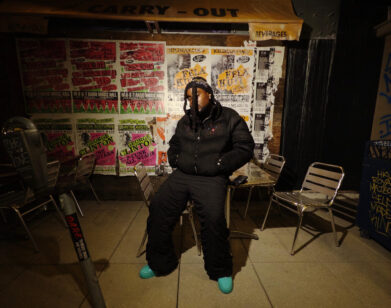Love and Other Drugs

Over the past four decades, Dr. Alexander “Sasha” Shulgin has created more than 200 psychedelic drug compounds, many involving MDMA—better known by its street name, ecstasy. The Northern California–bred scientist is the subject of a new documentary, Dirty Pictures—so named for the sketches of chemical compounds on the vials in Shulgin’s lab—though he is hardly a hedonist. Although the gray-bearded, tremulous-voiced Shulgin looks every bit the wizardly counter-cultural alchemist, the film depicts him as a serious researcher intent on expanding the frontiers of the mind; to him, psychoactive drugs are a gateway to true self-understanding and a potential salve for depression.
A former chemist for The Dow Chemical Company, the 85-year-old Shulgin left the corporate world in 1965 to pursue his preferred research, which he conducts from a ramshackle lab in the back of his Berkeley-area bungalow. (Shulgin won’t reveal the exact location of his house—though, he says, he no longer works with MDMA or other classifiably “illegal” drugs.) He met his wife, Ann, in 1979, and they immediately bonded over a mutual interest in visionary plants. At age 79, she is his research and writing partner. Dirty Pictures shows the Shulgins’ sampling new drug compounds with friends and associates—they call this experimenting. These scenes are intercut with the Shulgins’ travels—to the Burning Man festival in Nevada, to Egypt, to a symposium in New York City—and interviews with an amiable DEA agent and a chemist who’s developing psychedelic drugs for use in medicine but has never actually tried them himself.
In 1991, the Shulgins published the book PiHKAL: A Chemical Love Story, which describes their relationship and work—a bit too explicitly for some, who saw it as a drug cookbook. Coincidentally or not, three years later, the DEA raided their home and lab but found nothing illegal. Still, Shulgin was asked to surrender his DEA Schedule 1 license and was fined $25,000. A sequel, TiHKAL, followed in 1997, and now the pair are finishing up a giant index of psychoactive drugs. In a three-way chat, Sasha, Ann, and their assistant Tania discuss the mind-bending nature of their life’s work.
MICHAEL MARTIN: How did you feel about how you’re portrayed in the documentary?
ANN SHULGIN: I was just very sad that the whole thing wasn’t done after I lost 35 pounds. I think they did a great job. I very much enjoyed it. Of course, Sasha is almost blind, so he couldn’t very well see what’s on the screen.
SASHA SHULGIN: It’s probably just as well.
MARTIN: Sasha, it’s your birthday today. How are you going to celebrate?
SASHA: Live ’til 86.
MARTIN: Are you going to do any experimenting?
SASHA: Oh, no, no.
ANN: No time for that. People are dropping in.
SASHA: Morning, afternoon, the whole thing . . . So no getting into outer space, no way.
MARTIN: In the film, you seem to have a large social circle. Who are those people who are always hanging out at the house?
SASHA: [laughs] You handle that one, Ann.
ANN: There are a lot of people in the world who are interested in the action of these materials. And I don’t know how many people have come up to Sasha, or to both of us, and said, “You’ve changed my life.” Many have found perhaps they were in a state of severe depression, and they’ve taken MDMA.
SASHA: We haven’t changed their lives—they’ve changed their own lives.
ANN: And MDMA helped them gain access to parts of themselves that they hadn’t been able to open up before. It’s a very important experience for a lot of people. We have friends who don’t use psychoactive materials but who are still interested in how the brain works and psychology and spiritual training. It’s a very large and very intelligent bunch of people. We have two big parties each year where people bring food and drink and get to know each other. It makes a very good party.
SASHA: We have two rules: One is that you can’t come before noon. The other rule is you can stay as long as you want.
MARTIN: When you take MDMA, are you still able to discover new parts of yourselves?
ANN: We don’t take it now. It’s a scheduled drug [categorized as a Schedule 1 drug, which, according to the DEA, has no medical use and a high potential for abuse], so we don’t take it.
SASHA: Scheduling of drugs is a government problem, not our problem. They want to schedule something, that’s their problem. My feeling of creation is to make new drugs. They’re new drugs, so they’re unscheduled. They’ve never been made before.
ANN: We don’t have any scheduled drugs in the lab or house. We are always aware that the DEA is very interested and very hostile, and so we have no intention of doing anything that would tempt them to invade us again.
SASHA: Once they’ve made something scheduled, three or four years after I’ve invented it, I just throw my samples into the fireplace.
MARTIN: What are these new drugs you’re making?
SASHA: New psychedelic drugs, new materials that are totally unknown.
MARTIN: Are you concerned with taking these drugs? You don’t know how much to take or what effect they’ll have on you.
SASHA: Every brand-new drug is without advance knowledge. There’s no way of knowing. You take an amount that’s so small it’s not active. How much would you take?
ANN: The smallest amount. A nanogram.
SASHA: A nanogram may be potent material.
ANN: Then I would ask you.
MARTIN: Can you describe what you’re aiming to create—the optimal psychedelic drug?
SASHA: Optimal? No. If I had a vision of the perfect psychedelic drug and knew its structure, I’d make it. That’s why I have a laboratory out there—to make things that haven’t been made before.
ANN: Besides, every person’s body chemistry is different. The effect of one single drug that appeals to Sasha or to me might have a different effect on someone else. There’s no way to tell what the perfect psychedelic drug would be, because it would be perfect for only you.
Photos: (left) Notations from Dr. Alexander Shulgin’s laboratory notebook. Background: Ecstasy pills. Photo: © Scott Houston/Sygma/Corbis. (right) Dr. Shulgin in his backyard bungalow laboratory at an undisclosed location near Berkeley, California, 2005. Photo: © Jeff Minton/Corbis Outline.
If I had a vision of the perfect psychedelic drug and knew its structure, I’d make it. That’s why I have a laboratory out there—to make things that haven’t been made before. Dr. Alexander Shulgin
MARTIN: Sasha, a 2005 New York Times Magazine profile of you was titled “Dr. Ecstasy.” In the film, it’s said that you resent that label. Why?
SASHA: Well, first of all, I don’t know what “Dr. Ecstasy” means. Define ecstasy. What does it mean?
ANN: On the street as a drug, it means anything the chemist wants to put in it.
SASHA: Therefore it has no meaning.
ANN: The term ecstasy is a street name. The drug is illegal, and there is no quality control. There is no way to tell if there is any MDMA in it. One research group found that at a particular rave, one third of what was being sold as ecstasy had some MDMA in it. The rest did not, which is one of the dangers of making things illegal. There’s no protection. The authorities feel there should be no protection, but their views are somewhat different than ours.
MARTIN: The film shows you visiting Burning Man, which is not exactly known for pharmaceutical purism. But we never learn how you feel about the festival.
ANN: Approximately one third of the people at Burning Man take psychoactive drugs. The rest take alcohol. There’s not that much psychoactive drug taking.
SASHA: I think a lot of people assume they gather doped-out on psychoactive drugs. They don’t have them; they don’t even want them. They just happen to take a little bit of something or another and turn on and spin around a while.
ANN: If you haven’t been to Burning Man, you should do it once. It’s an extraordinary experience. Some of the best artwork I’ve ever seen in or out of a museum. Amazing. We’d love to go back, but it’s too expensive.
SASHA: We’ve been there three times, and that’s enough.
MARTIN: When you take drugs in the film, you call it experimenting. Do you ever call it getting high?
SASHA: No, because you don’t know if you’re going to get high! It’s new material, so it’s an experiment. About 99 percent of the time you take a drug, you have no effects at all. You continue on your normal day’s pattern, and then two days later you take another drug, and then three days later, you take another. You don’t go back to the same drug for another week or two or three.
ANN: That’s what we used to do. We haven’t done it for about five years. As you get older, the drugs have more effect than they did when you were younger. We have to cut down. At the moment, Sasha is on some medication that has the effect of extenuating psychedelics, so we have to be careful.
MARTIN: You haven’t taken anything for five years?
SASHA: Occasionally.
MARTIN: When you do, do you still learn new things about yourselves?
SASHA: Oh, yes. One of the most interesting people to learn about is yourself.
ANN: You contain a universe inside yourself. There’s no end to it—your conscious, your subconscious. There is no limit to what’s inside you. We are very much connected. There’s no end to it.
MARTIN: How often do you experiment?
ANN: These days . . .
SASHA: Not as much as I have in the past.
ANN: He’s been working on the book for five years. It’s just about two weeks away from being finished.
SASHA: It’s been that way for a year and a half.
ANN: But this time we think we have it.
MARTIN: What is the book about?
ANN: It’s called The Shulgin Index. It’s a reference book. Tania: It’s modeled after The Merck Index. There are probably 127 main entries of phenethylamine compounds and mind-altering drugs. They give you melting points, syntheses, human, and animal studies.
SASHA: One thing about it is that it’s just as viable to the authorities as to the psychedelic chemist. It has all factual material, and every comment that’s made is documented, tells where it’s been published. The authorities love that because they can go and get the originals. And people who are into psychedelic drugs can go and get the original. It’s of value both to law enforcement and people who are into psychedelic drugs.
MARTIN: Have you invented anything you consider to be as important as MDMA?
SASHA: I like 2C-B. I invented that. I don’t tend to go back on things that are known. I look for new things.
MARTIN: Once you invent something, what happens to it?
SASHA: I let others make it if they want to, or make it commercially if they want to. I want nothing more to do with it.Tania: If you investigate 2C-B, it became commercially available in Germany. It was called Nexus. And a South African tribe used it as a sacramental medicine. Then it became Schedule 1, and that’s it.
MARTIN: In the film, you describe one experiment you did together: You took a drug and concentrated on the hands of the clock. The hands got slower and slower until they threatened to stop. Sasha, you freaked and pulled yourself out of there.
SASHA: Put yourself in that place. If you’re looking at the hands of the clock, and they get slower and slower, what do you think is going to happen? I’m glad I got out of there before we stopped.
ANN: I think we could have gone further. He chickened out.
MARTIN: Your relationship is one of the most interesting things about the film. It’s a true romantic and professional partnership with roots in a pretty obscure interest.
ANN: The first conversation we ever had was about different things that altered consciousness. I had experienced one kind. He had a fascination with plants.
SASHA: Different channels, but the same interest.
ANN: He’s the scientist, and I’m the—
SASHA: You’re the artist.
ANN: I’m interested in the sensual aspect of the experience.
MARTIN: The film shows you being questioned at your house by authorities. Does that happen often?
SASHA: Not anymore. They came back one time, something about having seen something illegal in our back room. I was put out in their car—it was two o’clock in the afternoon, and by about 10 at night, they had gone through everything and maybe realized they had made a mistake. So half of them went home, and the other half started talking with us, and we invited them to stay for a cup of coffee and a glass of wine. They said, “What are you doing with illegal drugs?” And I said, “I don’t have any. The ones that are made illegal, I destroyed them.” What is it they’re making illegal? Things that I’ve found to be active and interesting. They’re making them illegal—it’s their problem, not mine. Once they realized there was nothing here to be found, they stopped coming.
MARTIN: Sasha, do you still have any relationship with the DEA?
SASHA: No.
Tania: Sasha has friends in the DEA he can’t talk to anymore. Their lives and careers are on the line—they have to report everything—so they can’t talk anymore.
ANN: Chemists love chemistry, and the chemists with the DEA are just as interested in the chemistry of the drugs. But the situation the way it is now, they can’t keep in contact with Sasha. They’re afraid of contamination.
MARTIN: You discuss the concept of consciousness in the film. Are you any closer to determining what that is?
SASHA: Oh, no.
ANN: I think the answer is in the spiritual realm. That’s not very scientific.
MARTIN: Do you think about mortality or wonder if your consciousness will extend beyond this physical realm?
SASHA: I think when you die, you die.
ANN: Of course I think exactly the opposite.
MARTIN: Do you ever argue about that?
SASHA: Oh, no.
ANN: We respect each other’s views. There are some things you don’t argue about because it’s a waste of time.
Michael Martin is a contributing editor to Interview.
Photo: Dr. Alexander Shulgin with his wife, Ann, outside their home near Berkeley, California, 2001. Photo: © Scott Houston/Sygma/Corbis.






